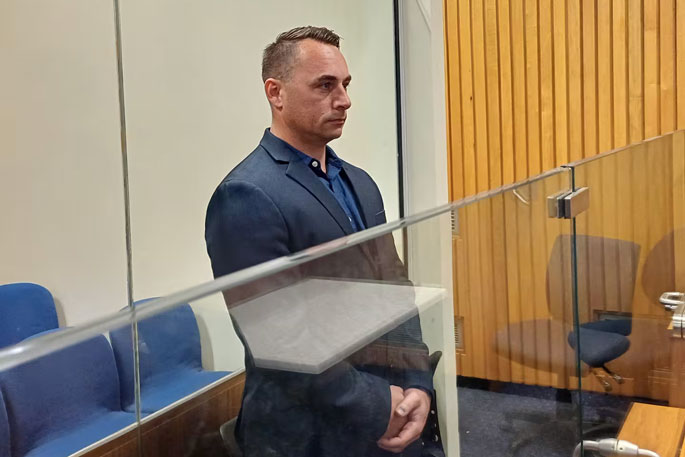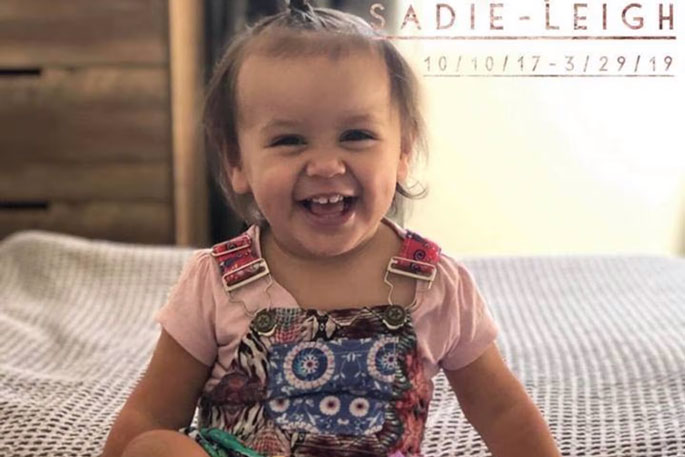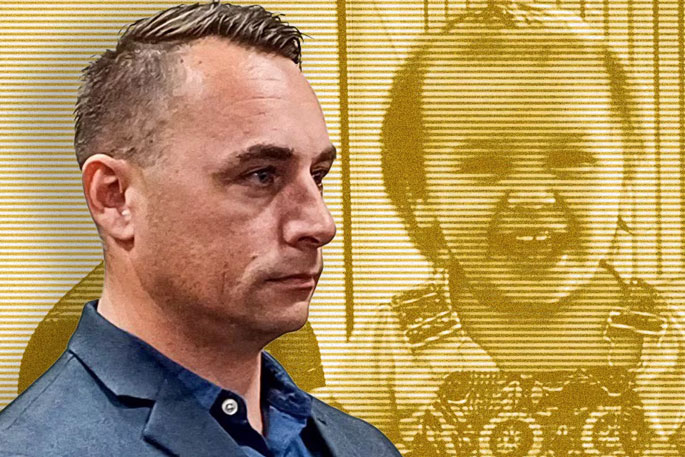Warning: This story contains medical evidence that may be distressing for some readers.
Toddler Sadie-Leigh Gardner suffered a blow to the head that was “akin to falls from a significant height or a road traffic accident.”
Experts have given evidence that within seconds of the impact the 17-month-old would likely have been unconscious, struggling to breathe, with blood building up inside her brain to the extent she would have no chance of survival.
Professor Colin Smith, a neuropathologist called by the Crown, said moments after Sadie-Leigh was either struck in the head or had her head struck against something, she would have been in a bad way.
“She would not have looked like a normal healthy child,” during week two of a murder trial.
The Crown alleges Adrian Clancy caused the fatal blow to Sadie-Leigh’s head while the toddler’s mother, his partner at the time, was at a beauty appointment in 2019. The defence argues Sadie-Leigh’s mother caused the injury and then left the toddler to go and get eyelash extensions.
The jury heard evidence last week that Sadie-Leigh was floppy and barely breathing when the 39-year-old defendant carried her to the neighbouring unit where CPR was started and an ambulance was called.
 Adrian Clancy carried the floppy and barely breathing 17-month-old to the neighbouring unit, where an ambulance was called. The toddler died less than 48 hours later.
Adrian Clancy carried the floppy and barely breathing 17-month-old to the neighbouring unit, where an ambulance was called. The toddler died less than 48 hours later.
Smith said at the moment of impact, the skull was cracked and bleeding in the brain began.
He said often with injuries of the type suffered by Sadie-Leigh, the child would be unconscious straight away, gasping for breath, and the heart would begin to struggle to pump blood around the body.
However under cross-examination by Clancy’s lawyer Rob Stevens, Smith conceded that it was difficult to definitively say how Sadie-Leigh would have immediately appeared to those caring for her.
While his initial assessment was that respiratory distress would be an issue “within seconds” of the impact, he conceded it could have been “minutes” before her breathing appeared laboured to an observer.
When Stevens suggested it could have been as long as “10-15 minutes”, Smith said that would be at the “extreme limits” of a possible window.
He also said it was possible that Sadie-Leigh could have been drifting in and out of consciousness, rather than immediately unconscious.
“As soon as this head injury has happened, she’s a very unwell little girl,” he said under reexamination.
Floppiness and a loss of control of limbs, including seizures, were also common with this degree of head injury.
He said as the brain began to bleed immediately after impact, it would have been harder for her heart to pump the blood to the brain, and as the blood clot increased, the heart function would have become even worse, in a vicious cycle.
Imaging taken both before and after Sadie-Leigh died showed extensive bleeding, both on the surface of the brain, within the brain, and into her eyes.
The loss of blood flow would have caused the brain to swell, and he’d seen evidence of the brain moving out of the skull due to the swelling.
He said by the time Sadie-Leigh was found unconscious and then attended to by paramedics she was moribund - essentially already dying.
Not normal childhood injuries
Sadie-Leigh’s brain injury was irreversible and “non-survivable”, and surgery hadn’t been an option when she arrived at Starship Children’s Hospital in Auckland.
 Sadie-Leigh Gardner suffered significant brain bleeds that were non-survivable and inoperable.
Sadie-Leigh Gardner suffered significant brain bleeds that were non-survivable and inoperable.
Dr Russell Metcalfe, a paediatric radiologist from Starship, said the level of injuries Sadie-Leigh presented with were well beyond what you’d expect from normal childhood injuries.
He’d identified damage to her head and neck that indicated she’d been shaken, and also either been hit in the head with something or had her head slammed into something.
Upon re-examining a CT scan taken at Tauranga Hospital, he’d also spotted a fracture to her scapula - in layman’s terms her shoulder blade.
He said this was an unusual injury for a child of this age given the area was surrounded by muscle.
He said when it did happen, it was typically associated with events that caused forceful direct impact on the area - for example, a fall from a tree, or a child coming off a bike at high speed, and landing on the shoulder blade.
It was his opinion this injury was caused at the same time as the skull fracture and ligament damage, but from a separate blow than that to her head.
He said she had likely been struck from behind with force, but given the injury would have been painful, he thought it probably happened at the same time as the head injuries, as caregivers would have noticed her in pain when holding her, dressing her, or moving her arm.
The defence challenged him on this point repeatedly, stating that histological evidence - that of the cellular changes around the injury - seemed to indicate there had been healing at a cellular level examined at a microscopic level.
Metcalfe said his discussions with the pathologist who’d done the histology indicated the given window of time meant the injury could still have happened at the same time as the other injuries, even with the healing at a cellular level, but neither he nor the pathologist could give precise timing.
Metcalfe said his opinion was also based on other factors. The level of force and nature of the injury was unusual enough to make him “suspicious” it happened at the same time as the other trauma.
The level of brain bleeding caused by the skull fractures showed a “different level” of force than common injuries like toppling from a shopping trolley or falling from a couch.
“With normal childhood injuries you don’t come in essentially dead,” he said.
He confirmed the head injuries must have happened in the afternoon before she was admitted to hospital.
“She would have been instantly recognisable as injured or unwell,” he said.
Paediatrician Dr Jeanine Nunn said based on clinical experience, children who suffered the level of head injury experienced by Sadie-Leigh would be “immediately symptomatic” and “quite abnormal”.
Crown prosecutor Richard Jenson asked whether, if a child were still conscious, they would be responding in pain following the injuries.
“I’m not sure they’re conscious enough to know if there is pain,” she said.
The trial continues.





0 comments
Leave a Comment
You must be logged in to make a comment.